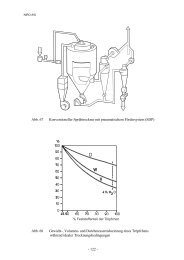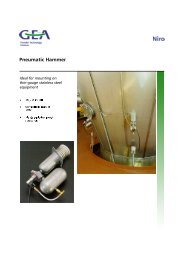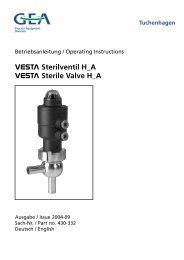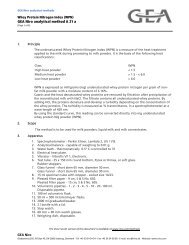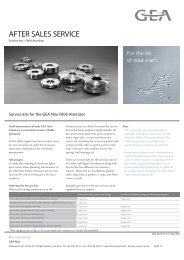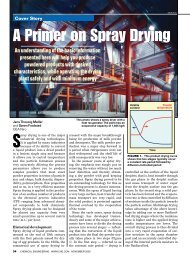41119_Niro jubilaeumsbog_blok_uk - GEA Niro
41119_Niro jubilaeumsbog_blok_uk - GEA Niro
41119_Niro jubilaeumsbog_blok_uk - GEA Niro
Create successful ePaper yourself
Turn your PDF publications into a flip-book with our unique Google optimized e-Paper software.
New demands from customers and new<br />
types of plants<br />
To meet customers’ demands, <strong>Niro</strong> develops<br />
the TALL FORM DRYER, the SPRAY<br />
FLUIDIZER, the COMPACT DRYER, the<br />
FILTERMAT ® and the Fluidized Spray Dryer<br />
(FSD) and makes more standardized plant<br />
types with wheels and nozzle atomization.<br />
Already in the early 1980s, the demand for<br />
increased accuracy and speed in design<br />
and the project phases made EDB and<br />
later IT important working tools for <strong>Niro</strong>’s<br />
employees.<br />
62 | 63<br />
Renovation of facilities and plants<br />
Many of <strong>Niro</strong>’s customers in the traditional<br />
industrial countries in Western<br />
Europe renovate and update their<br />
plants. Some companies choose to<br />
focus on special products, which often<br />
demand special drying plants. Other<br />
companies redirect their activity into<br />
the pharmaceutical business. Furthermore,<br />
increased requirements for<br />
environmental and occupational safety<br />
demand an upgrade of many existing<br />
plants.<br />
Need for increased drying capacity in<br />
China and India<br />
The need for <strong>Niro</strong>’s technology and knowledge<br />
increases in recent years, particularly from<br />
China and India, where increased prosperity<br />
and population growth result in greater<br />
consumption of dried products.<br />
Plant size grows<br />
The consumption of chemical products, food<br />
and other products increases steadily, and<br />
<strong>Niro</strong>’s plants grow as well. Over the last 30-40<br />
years the capacity of <strong>Niro</strong>’s biggest plant has<br />
grown tenfold. From the 1970s, plants that<br />
can produce 10-20 tons of powder per hour<br />
plus handle higher temperatures of 800-1,000°C<br />
are increasingly in demand.<br />
Demand also increases for atomizers specially<br />
designed for high speeds. Today, atomizers<br />
rotate creating velocities of more than 1,000<br />
km per hour.



